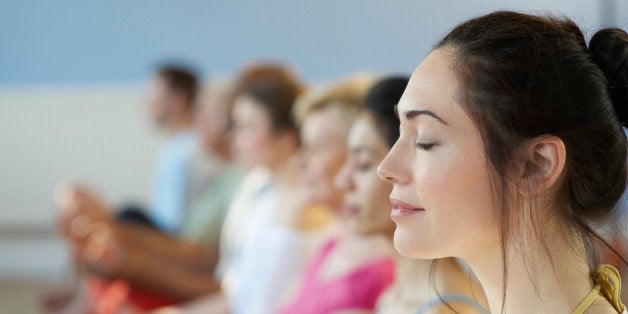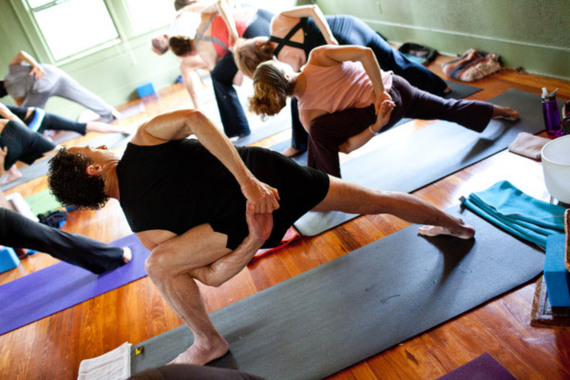
It seems we can't go a day without hearing something new about the health benefits of meditation. Earlier last week, researchers from the Department of Defense and Georgia Regents University found that Transcendental Meditation could be used to treat veterans suffering from PTSD, suggesting further research into using meditation as a supplementary treatment.
The list of health benefits can go on. Different forms of meditation have the capacity to reduce blood pressure, relieve anxiety, and improve responses to stress. We've also heard countless testaments from celebrities, businessmen, and everyday individuals talking about the interconnectedness of abundance, peace, rediscovery, and meditation.
But I would like to add my voice to the list. Not because I am reborn celebrity or a famous CEO, but because I was a curious student in need of exercise and some stress relief and I was awestruck by the possibilities of meditation. I happened upon it almost by accident.
During the summer of 2013, I was looking to get in shape using some different methods which did not involve constantly lifting weights at the university rec center. After some months of trying bodyweight workouts, I discovered Hatha and Vinyasa Yoga classes were offered free of charge to students at my university. I was immediately attracted.
Now obviously I had heard about yoga before, but I didn't know much more other than it was an Eastern practice with ancient roots that now featured more sorority girls wearing Lululemon than the robe-wearing Yogis of the Indian Peninsula. I also had no idea that meditation exercises usually followed most yoga practices.
My first practice was a guided hour of Vinyasa Yoga, an ancient style rooted in Hindu origins and Hatha Yoga. The term vinyasa itself holds many meanings in Sanskrit, but generally translates to "arranging something in a special way" or "connection," emphasizing the use of breath when moving between different asanas, or poses.
After some 45 minutes of a challenging practice, our guide instructed us to lie down on our mats, relaxing our muscles and facing our palms to the sky. For the next 10 or so minutes, I was mystified. Light background music and complete silence seemed a complete bore to me. 'What a terrible way to end the class," I thought to myself.
My mind kept racing with the menial tasks and errands I had to complete before the day was done. I can say with complete honesty that my first attempt at meditation was an utter failure. Nevertheless, I enjoyed the 45 minutes of yoga and resolved to go twice a week to these classes.
At what point the fat lady sang or the cows came home, I don't know. But after some classes and forced attempts at meditation, something clicked. The effects began to creep into my mind and body. Leaving an exhausting yoga class was like leaving the massage parlor: I was refreshed, invigorated, and tranquil. The thousands of random thoughts that constantly bombarded my mind soon dissipated, and I could control the rate at which these invasive ideas attacked.
I could not get enough of it. My foray into what is called Mindfulness Meditation had left me addicted to a completely novel feeling, alien to anything I had ever experienced before. My everyday life was affected by the daily practice of meditation, instilling a feeling of satisfaction and peace I have failed to find anywhere else.
Mindfulness Meditation originated in Buddhism and, for beginners, consists of one sitting or lying silently, focusing on the inhale and exhale of the breath, and maintaining a passive state of mind. If you find yourself wandering, as I often do, on thoughts other than your breath, simply return your awareness to your breath and let go of all other thoughts.
The idea sounds much easier on paper and in reality is a difficult feat to accomplish. If you are anything like me, you often find your mind on ten different things at the same time, calculating how and when you can complete your daily tasks. This is called "noise." While it might not have a measurable wavelength of sound, it can be piercingly earsplitting within the confines of one's own psyche.
Practitioners of meditation often say the mind is like a muscle, it must be worked again and again in order for its strength to develop and the effects of meditation to transcend quotidian experiences. Daily meditation is the best manner in which to develop the muscles of the mind, maintaining a daily practice, if only for 10-15 minutes. Integrating this into any routine would have untold physical and psychological benefits.
I now find myself sounding like a long-haired hippie, going up to friends or family and saying, "Dude, I'm telling you, you have to try meditation." The initial reaction is always surprise, as if a jolt of energy was just sent up their spinal cord. But I recommend that you blend the practice with an hour of yoga.
Practicing meditation after a fit amount of yoga will leave you tired and more receptive to the transcendence of meditation. Or simply try it after your next workout. Add 15 minutes next time you're at the gym, play a guided meditation on your phone and sit or lie down on some mats. You can even use the one in the link here.
Chances are you won't regret it.


